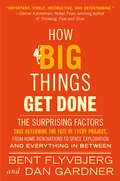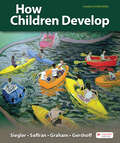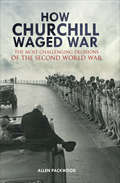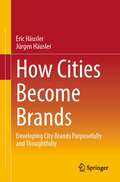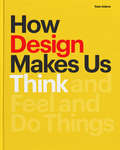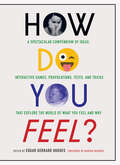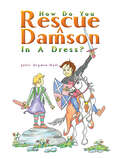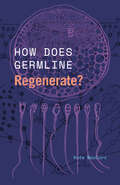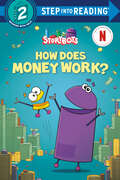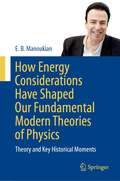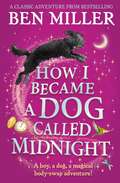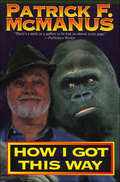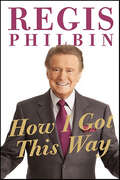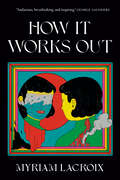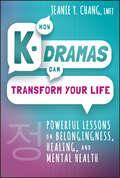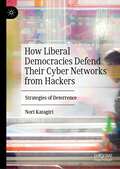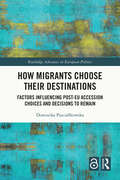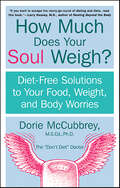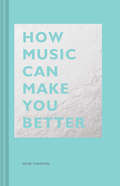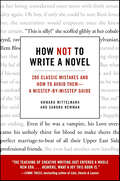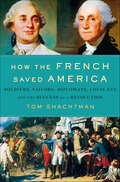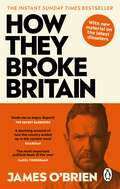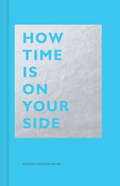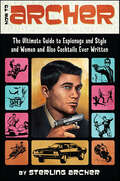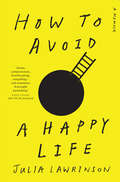- Table View
- List View
How Big Things Get Done: The Surprising Factors That Determine the Fate of Every Project, from Home Renovations to Space Exploration and Everything In Between
by Bent Flyvbjerg Dan Gardner&“Why do big projects go wrong so often, and are there any lessons you can use when renovating your kitchen? Bent Flyvbjerg is the &‘megaproject&’ expert and Dan Gardner brings the storytelling skills to How Big Things Get Done, with examples ranging from a Jimi Hendrix studio to the Sydney Opera House.&”—Financial Times &“Entertaining . . . There are lessons here for managers of all stripes.&”—The EconomistA BEST BOOK OF THE YEAR: Economist, Financial Times, CEO Magazine, MorningstarFinalist for the Porchlight Business Book Award, the Financial Times and Schroders Business Book of the Year Award, and the Inc. Non-Obvious Book AwardNothing is more inspiring than a big vision that becomes a triumphant, new reality. Think of how the Empire State Building went from a sketch to the jewel of New York&’s skyline in twenty-one months, or how Apple&’s iPod went from a project with a single employee to a product launch in eleven months.These are wonderful stories. But most of the time big visions turn into nightmares. Remember Boston&’s &“Big Dig&”? Almost every sizeable city in the world has such a fiasco in its backyard. In fact, no less than 92% of megaprojects come in over budget or over schedule, or both. The cost of California&’s high-speed rail project soared from $33 billion to $100 billon—and won&’t even go where promised. More modest endeavors, whether launching a small business, organizing a conference, or just finishing a work project on time, also commonly fail. Why?Understanding what distinguishes the triumphs from the failures has been the life&’s work of Oxford professor Bent Flyvbjerg, dubbed &“the world&’s leading megaproject expert.&” In How Big Things Get Done, he identifies the errors in judgment and decision-making that lead projects, both big and small, to fail, and the research-based principles that will make you succeed with yours. For example:• Understand your odds. If you don&’t know them, you won&’t win.• Plan slow, act fast. Getting to the action quick feels right. But it&’s wrong. • Think right to left. Start with your goal, then identify the steps to get there.• Find your Lego. Big is best built from small.• Be a team maker. You won&’t succeed without an &“us.&”• Master the unknown unknowns. Most think they can&’t, so they fail. Flyvbjerg shows how you can.• Know that your biggest risk is you.Full of vivid examples ranging from the building of the Sydney Opera House, to the making of the latest Pixar blockbusters, to a home renovation in Brooklyn gone awry, How Big Things Get Done reveals how to get any ambitious project done—on time and on budget.
How Children Develop, Canadian Edition
by Robert Siegler Jenny Saffran Susan Graham Nancy Eisenberg Elizabeth GershoffHow Children Develop, Seventh Edition, is the trusted introduction to child development in Canada from a team of leading teachers and researchers.
How Churchill Waged War: The Most Challenging Decisions of the Second World War
by Allen PackwoodAn analytical investigation into Prime Minister Winston Churchill&’s decision-making process during every stage of World War II. When Winston Churchill accepted the position of Prime Minister in May 1940, he insisted in also becoming Minister of Defence. This, though, meant that he alone would be responsible for the success or failure of Britain&’s war effort. It also meant that he would be faced with many monumental challenges and utterly crucial decisions upon which the fate of Britain and the free world rested. With the limited resources available to the UK, Churchill had to pinpoint where his country&’s priorities lay. He had to respond to the collapse of France, decide if Britain should adopt a defensive or offensive strategy, choose if Egypt and the war in North Africa should take precedence over Singapore and the UK&’s empire in the East, determine how much support to give the Soviet Union, and how much power to give the United States in controlling the direction of the war. In this insightful investigation into Churchill&’s conduct during the Second World War, Allen Packwood, BA, MPhil (Cantab), FRHistS, the Director of the Churchill Archives Centre, enables the reader to share the agonies and uncertainties faced by Churchill at each crucial stage of the war. How Churchill responded to each challenge is analyzed in great detail and the conclusions Packwood draws are as uncompromising as those made by Britain&’s wartime leader as he negotiated his country through its darkest days.
How Cities Become Brands: Developing City Brands Purposefully and Thoughtfully
by Eric Häusler Jürgen HäuslerThis book explores how the fragile and lengthy process of developing a city brand can be carefully managed. Necessary background information is explained, numerous experiences are reported, and targeted city branding is inspired in a variety of ways.The dream of every brand maker: to develop a city into a strong city brand - perhaps even a myth. The creation of myths remains a curiosity. Is it targeted, are there relevant recipes for success, and can those responsible be identified? Above all: Can the process be replicated? How do brand makers deal with the complexity of the phenomena of cities and city brands? How do they give the arduous process of creating a city brand a reasonable chance of success? How do brand makers deal with the often biting criticism from outside and the nagging self-doubt?Successful cityscapes arise from the trials and tribulations of complex and sometimes random processes. In the course of global city competition, this evolutionaryprocess is enriched with the achievements of the craft of branding. This is not a guarantee of success. Success depends on numerous prerequisites, which are discussed in detail. Finally, craft rules for good and at the same time sensitive city branding are mentioned.The translation was done with the help of artificial intelligence. A subsequent human revision was done primarily in terms of content.nal criticism and self-doubts?City images emerge from complex and random processes. In global urban competition, this process is enriched with brand making achievements. Success isn't guaranteed, depending on discussed conditions. Lastly, rules for effective city branding are outlined.nal criticism and self-doubts?City images emerge from complex and random processes. In global urban competition, this process is enriched with brand making achievements. Success isn't guaranteed, depending on discussed conditions. Lastly, rules foreffective city branding are outlined.nal criticism and self-doubts?City images emerge from complex and random processes. In global urban competition, this process is enriched with brand making achievements. Success isn't guaranteed, depending on discussed conditions. Lastly, rules for effective city branding are outlined.nal criticism and self-doubts?City images emerge from complex and random processes. In global urban competition, this process is enriched with brand making achievements. Success isn't guaranteed, depending on discussed conditions. Lastly, rules for effective city branding are outlined.nal criticism and self-doubts?City images emerge from complex and random processes. In global urban competition, this process is enriched with brand making achievements. Success isn't guaranteed, depending on discussed conditions. Lastly, rules for effective city branding are outlined.nal criticism and self-doubts?City images emergefrom complex and random processes. In global urban competition, this process is enriched with brand making achievements. Success isn't guaranteed, depending on discussed conditions. Lastly, rules for effective city branding are outlined.nal criticism and self-doubts?City images emerge from complex and random processes. In global urban competition, this process is enriched with brand making achievements. Success isn't guaranteed, depending on discussed conditions. Lastly, rules for effective city branding are outlined.City images emerge from complex and random processes. In global urban competition, this process is enriched with brand making achievements. Success isn't guaranteed, depending on discussed conditions. Lastly, rules for effective city branding are outlined.City images emerge from complex and random processes. In global urban competition, this process is enriched with brand making achievements. Success isn't guaranteed, depending on discussedconditions. Lastly, rules for effective city branding are outlined.City images emerge from
How Design Makes Us Think: And Feel and Do Things
by Sean AdamsFrom posters to cars, design is everywhere. While we often discuss the aesthetics of design, we don't always dig deeper to unearth the ways design can overtly, and covertly, convince us of a certain way of thinking. How Design Makes Us Think collects hundreds of examples across graphic design, product design, industrial design, and architecture to illustrate how design can inspire, provoke, amuse, anger, or reassure us.Graphic designer Sean Adams walks us through the power of design to attract attention and convey meaning. The book delves into the sociological, psychological, and historical reasons for our responses to design, offering practitioners and clients alike a new appreciation of their responsibility to create design with the best intentions. How Design Makes Us Think is an essential read for designers, advertisers, marketing professionals, and anyone who wants to understand how the design around us makes us think, feel, and do things.
How Do You Feel?: Understand Your Emotions through Charts, Tests, Questionnaires, and Interactive Games
by Edgar Gerrard HughesAn insightful and fun interactive guide to understanding the what, how, and why of your emotions.Almost every moment of our lives is suffused with emotion, yet we rarely think about what these emotions mean, how they're formed, and how to address them. How Do You Feel? gathers decades of recent research on emotions in accessible short essays and engaging activities that let you be your own guide in learning about your emotions. With questionnaires, quizzes, assessments, and more, How Do Your Feel? is great for groups or individuals, and will entertain, inform, surprise, and help you get to know yourself better.
How Do You Rescue a Damson in a Dress?
by Julie Dryden-HallEmbark on a whimsical tale of curiosity, adventure, sibling camaraderie, and a sprinkle of delightful misinterpretation in How Do You Rescue a Damson In A Dress? With eyes sparkling with wonder and a heart buoyed by courage, our young prince gallantly trails behind his elder brother, embarking on what he believes to be a noble quest to rescue a ‘Damson in a Dress.’ Unbeknownst to him, his brother is on a mission to save a Damsel in Distress. Armed with a valiant sword, a stash of sweets, and a flask of milk to quench his thirst, the young prince steps into a world brimming with enchanting adventures yet perilous encounters. His path intertwines with a formidable grizzly bear, a cunning and greedy wolf, a menacing crocodile, and the mythical Nessy Monster. Despite the lurking dangers, his youthful bravado never wavers. As the veil of misinterpretation humorously unfolds, will our young hero find the ‘Damson’ he seeks? Or will he discover a greater understanding of his brother’s true quest?
How Does Germline Regenerate? (Convening Science: Discovery at the Marine Biological Laboratory)
by Kate MacCordA concise primer that complicates a convenient truth in biology—the divide between germ and somatic cells—with far-reaching ethical and public policy ramifications. Scientists have long held that we have two kinds of cells—germ and soma. Make a change to germ cells—say using genome editing—and that change will appear in the cells of future generations. Somatic cells are “safe” after such tampering; modify your skin cells, and your future children’s skin cells will never know. And, while germ cells can give rise to new generations (including all of the somatic cells in a body), somatic cells can never become germ cells. How did scientists discover this relationship and distinction between somatic and germ cells—the so-called Weismann Barrier—and does it actually exist? Can somatic cells become germ cells in the way germ cells become somatic cells? That is, can germ cells regenerate from somatic cells even though conventional wisdom denies this possibility? Covering research from the late nineteenth century to the 2020s, historian and philosopher of science Kate MacCord explores how scientists came to understand and accept the dubious concept of the Weismann Barrier and what profound implications this convenient assumption has for research and policy, from genome editing to stem cell research, and much more.
How Does Money Work? (Step into Reading)
by Scott EmmonsThe robots from Netflix's StoryBots Answer Time star in an all-new Step 2 Step into Reading leveled reader!Bing wants to know what money is and why we use it. His questions lead him from a bank to a tour of a successful lemonade stand. What he learns will fascinate children ages 4 to 6 who love Netflix's educational show.Step 2 Readers use basic vocabulary and short sentences to tell simple stories. For children who recognize familiar words and can sound out new words with help.
How Energy Considerations Have Shaped Our Fundamental Modern Theories of Physics: Theory and Key Historical Moments
by E. B. ManoukianAt long last, with sufficient technical details, emphasizing key historical moments, a book that develops all of fundamental modern theoretical physics from energy considerations in a compact form. Starting with a few electron-volts of atoms in the quantum world at low energies extending up to quantum gravity and beyond to the birth of the Universe, readers will experience the entire spectrum of fundamental modern theoretical physics, with one theory leading to another in an integrated unified manner. Energy considerations lead to the development of special and general relativity, quantum field theory, renormalization theory, modern quantum electrodynamics, electro-weak theory, the standard model of particle physics, grand unified theories, string theory, the current standard model of inflationary big bang theory, and even to the birth of the Higgs field, and in developments of quantum gravity. Unfortunately, due to strong specialization within theirfields, students and many practicing physicists are exposed only to parts of the beautiful story of modern fundamental physics. Here the entire story is told! This is a must-read book for graduate students, advanced undergraduate students, instructors and professionals who are interested in all aspects of fundamental modern theoretical physics and key historical moments in its development.
How I Became a Dog Called Midnight: A magical adventure from the bestselling author of The Day I Fell Into a Fairytale
by Ben Miller'Wonderful, funny, magical' Chris Evans&‘A sheer delight for all kids both big AND small&’ Ruth Jones on The Night I Met Father Christmas 'Bubbles with warmth and mischievous humour . . . irresistible' Alexander Armstrong on The Night I Met Father ChristmasA boy, a dog, and a magical body-swap adventure! Enter a world of wonder in this classic adventure from top-ten bestselling children's author, Ben Miller. George has always wondered what it's like to be a dog. One night, a magical mix-up with an enchanted fountain means he swaps places with Midnight, a huge and loveable hound! Becoming a dog is an amazing adventure, until George uncovers a plan that could threaten Midnight's home. Can the two friends save the day before the clock strikes twelve and leaves them stuck in each other's bodies forever? A magical race-against-time for a boy and his dog best friend – discover the funny and heartwarming classic storytelling from bestselling author and beloved actor, Ben Miller.*The Night We Got Stuck in a Story – a brand-new, magical adventure from bestselling author, Ben Miller – is out now!*Praise for Ben Miller:'A magical adventure' Sunday Express on The Day I Fell Into a Fairytale'Great for reading aloud' The Week Junior on The Day I Fell Into a Fairytale'A fire-side gem of a story' Abi Elphinstone on The Night I Met Father Christmas'Fabulous' Sunday Express on The Boy Who Made the World Disappear'Enchanting, funny and intriguing in equal measure' Philip Ardagh on The Night I Met Father Christmas'Each of [Ben&’s] five books is joyous and thoughtful' Red Magazine
How I Got This Way
by Patrick F. McManusPatrick McManus, the bestselling author of such hilarious books as A Fine and Pleasant Misery and Never Sniff a Gift Fish, now offers readers solid thoughts on the qualities that define leadership, beginning with the need to be tall, and much more, in this outrageous collection of short pieces that reveals his tortuous trip along the writer's path.
How I Got This Way
by Regis PhilbinIn this entertaining memoir, the irrepressible "Reege" - consummate talk show host, man about town, loving husband, father, and yes, obsessive sports fan-looks back at his years in show business. One of the most popular television and cultural icons ever, Regis Philbin entertained television audiences for more than fifty years—as a beloved morning-show host (Live with Regis and Kelly), a nighttime game-show host (Who Wants to Be a Millionaire?) and also as a fixture on national and local late-night talk shows. The irrepressible “Reege” has regaled television audiences with his stories for more than half a century, but he’s saved the most hilarious, surprising, heartfelt, and inspiring tales for How I Got This Way. Both a fascinating show business memoir and a delightful primer for living the good life rolled into one, How I Got This Way is Reege being Reege, just the way we love him, as he shares the secrets to success and happiness that he has learned from his innumerable celebrity encounters, his close, personal friendships, and, of course, his relationship with his loving wife and family.
How It Works Out
by Myriam Lacroix&“Audacious, breathtaking, and inspiring.&” —GEORGE SAUNDERS&“Madcap, delirious, exhilaratingly good.&” —KELLY LINK&“A delightfully bizarre and unabashedly queer revelation.&” —TEGAN and SARA QUIN &“A beautifully brilliant, hilariously sad stunner of a debut that never forgets about the heart.&” —NANA KWAME ADJEI-BRENYAHWhat if you had the chance to rewrite the course of your relationship, again and again, in the hopes that it would work out?When Myriam and Allison fall in love at a show in a run-down punk house, their relationship begins to unfold through a series of hypotheticals. What if they became mothers by finding a baby in an alley? What if the only cure for Myriam&’s depression was Allison&’s flesh? What if they were B-list celebrities, famous for writing a book about building healthy lesbian relationships? How much darker—or sexier—would their dynamic be if one were a power-hungry CEO, and the other her lowly employee? From the fantasies of early romance to the slow encroaching of violence that unravels the fantasy, each reality builds to complete a brilliant, painfully funny portrait of love&’s many promises and perils.Equal parts sexy and profane, unsentimental, and gut-wrenching, How It Works Out is a genre-bending, arresting, uncanny exploration of queerness, love, and our drive for connection, in any and all possible worlds.
How K-Dramas Can Transform Your Life: Powerful Lessons on Belongingness, Healing, and Mental Health
by Jeanie Y. ChangDiscover the power of how K-Dramas can improve your wellbeing and provide a sense of belonging Love K-Dramas and want more permission to binge watch them? In How K-Dramas Can Transform Your Life: Powerful Lessons on Belongingness, Healing, and Mental Health, Licensed Marriage and Family Therapist Jeanie Y. Chang explores what K-Dramas can teach us about our own well-being and how we can use the lessons they teach us to live better and more meaningful lives. She also touches upon the powerful interrelationship between K-dramas, mental health, and belongingness. Topics covered include: Using K-Dramas as a roadmap to life, showing you how to navigate speed bumps, roadblocks, twists, turns, and dead ends Building cross-cultural relationships that you otherwise may not have without being a K-Drama fan Processing grief from the loss of a loved one to a loss of anything—a job, your physical safety, a relationship, or something else Harnessing the idea of Jeong, which is innate in Korean society and refers to the emotional sentiment of affinity, affection, kinship, and connection which is the thread throughout Jeanie's community Working the author’s trademarked mental health framework, Cultural Confidence®, to build up your mental health, identity, mindfulness, and resilience For K-Drama fans and enthusiasts and anyone curious about the influence of pop culture, How K-Dramas Can Transform Your Life is an entertaining and educational must-read on how this enormously popular global phenomenon can help us become the best versions of ourselves.
How Liberal Democracies Defend Their Cyber Networks from Hackers: Strategies of Deterrence
by Nori KatagiriThis book outlines the main technological, legal, and operational options that liberal democratic nations have when confronting challenges in cyberspace. It offers a range of policy ideas they can adopt to make their defense stronger and deter future cyber-attacks. The author explores how liberal societies, especially those in the Western world, have so far confronted a variety of cybersecurity challenges by hackers in nondemocratic regimes like Russia and China. and zooms in on the main challenges that democratic states face in adopting strategies of cyber deterrence, and how those challenges shape their ability to actually deter hackers.
How Migrants Choose their Destinations: Factors Influencing Post-EU Accession Choices and Decisions to Remain (ISSN)
by Dominika PszczółkowskaThis book reveals how decisions regarding where to migrate are made, what factors are considered, how these change over time and why some destinations are more attractive to certain categories of people.Based on rich existent, and new data, the book explains the destination choices of Polish migrants to the four most frequently chosen destinations countries: the UK, Ireland, Germany and the Netherlands. Examined through a sophisticated theoretical framework allowing for the incorporation of factors resulting from several fields – economics, public policies, demography – and migration theories, it paints a nuanced and balanced picture of European migration.This book will be of key interest to scholars and students of migration studies, Central and Eastern European politics, and more broadly to sociology, political science, social geography and international relations.
How Much Does Your Soul Weigh?: Diet-Free Solutions to Your Food, Weight, and Body Worries
by Dorie McCubbreyYou hold in your hands a life-changing weight control revelation -- a holistic approach to help you overcome all eating and weight problems from anorexia to obesity. This innovative book will shed light on your unsuccessful attempts at dieting and help you begin to heal from the inside out, once and for all!How many "miracle diets" have you tried? How many minutes and hours have you spent worrying about the numbers on the bathroom scale? How many times have you lost weight only to gain it back along with renewed disappointment and frustration? You've worried about how much your body weighs, but have you asked: How Much Does Your Soul Weigh?Dr. Doric McCubbrey, a weight-issues specialist whose practice boasts a 95 percent success rate, reveals that the weight of your soul may be preventing you from effecting the changes you want to see in your appearance and self-esteem. By starting Dr. Dorie's plan for "Intuitive Self-Care," you can begin to unburden your soul of all the "weighty attitudes" of the diet mentality -- rigid rules, negative self-talk, and unrealistic goals -- that lead to very real feelings of disappointment and hopelessness.With empathy and insight, Dr. Doric explores and explains the importance of a soulful attitude toward your eating, exercise, and weight. You'll discover:the "games" dieters play -- and why none of them worksthe four archetypal weight problems and how to overcome them for goodthe secrets of naturally thin people -- and how you can incorporate them into your lifea 30-day plan of therapeutic "recipes" designed especially to nourish your soulPacked with stories from Dr. Dorie's own 15-year struggle with overeating, anorexia, and bulimia, and the experiences of her clients, How Much Does Your Soul Weigh? shows you how to generate the happiness, health, balance, and confidence that will put your weight worries to rest for good!
How Music Can Make You Better: (motivational Book, Neuroscience Book) (The HOW Series)
by Indre Viskontas PhDHow can certain songs carry us through a tough workout, comfort us after a breakup, or unite 50,000 diverse fans? In this fascinating field guide, neuroscientist and opera singer Indre Viskontas investigates what music is and how it can change us for the better—from deep in our neurons to across our entire society. Whether hip-hop fans, classically trained pianists, or vinyl collectors, readers will think about their favorite songs in a whole new way by the end of this book. This is a vibrant and smart gift for any audiophile.
How Not to Write a Novel: 200 Classic Mistakes and How to Avoid Them—A Misstep-by-Misstep Guide
by Howard Mittelmark Sandra Newman"What do you think of my fiction book writing?" the aspiring novelist extorted. "Darn," the editor hectored, in turn. "I can not publish your novel! It is full of what we in the business call 'really awful writing.'" "But how shall I absolve this dilemma? I have already read every tome available on how to write well and get published!" The writer tossed his head about, wildly."It might help," opined the blonde editor, helpfully, "to ponder how NOT to write a novel, so you might avoid the very thing!"Many writing books offer sound advice on how to write well. This is not one of those books. On the contrary, this is a collection of terrible, awkward, and laughably unreadable excerpts that will teach you what to avoid—at all costs—if you ever want your novel published. In How Not to Write a Novel, authors Howard Mittelmark and Sandra Newman distill their 30 years combined experience in teaching, editing, writing, and reviewing fiction to bring you real advice from the other side of the query letter. Rather than telling you how or what to write, they identify the 200 most common mistakes unconsciously made by writers and teach you to recognize, avoid, and amend them. With hilarious "mis-examples" to demonstrate each manuscript-mangling error, they'll help you troubleshoot your beginnings and endings, bad guys, love interests, style, jokes, perspective, voice, and more. As funny as it is useful, this essential how-NOT-to guide will help you get your manuscript out of the slush pile and into the bookstore.
How the French Saved America: Soldiers, Sailors, Diplomats, Louis XVI, and the Success of a Revolution
by Tom ShachtmanAmericans today have a love/hate relationship with France, but in How the French Saved America Tom Shachtman shows that without France, there might not be a United States of America.To the rebelling colonies, French assistance made the difference between looming defeat and eventual triumph. Even before the Declaration of Independence was issued, King Louis XVI and French foreign minister Vergennes were aiding the rebels. After the Declaration, that assistance broadened to include wages for our troops; guns, cannon, and ammunition; engineering expertise that enabled victories and prevented defeats; diplomatic recognition; safe havens for privateers; battlefield leadership by veteran officers; and the army and fleet that made possible the Franco-American victory at Yorktown. Nearly ten percent of those who fought and died for the American cause were French. Those who fought and survived, in addition to the well-known Lafayette and Rochambeau, include François de Fleury, who won a Congressional Medal for valor, Louis Duportail, who founded the Army Corps of Engineers, and Admiral de Grasse, whose sea victory sealed the fate of Yorktown. This illuminating narrative history vividly captures the outsize characters of our European brothers, their battlefield and diplomatic bonds and clashes with Americans, and the monumental role they played in America’s fight for independence and democracy.
How They Broke Britain: The Instant Sunday Times Bestseller
by James O'Brien***THE RUNAWAY BESTSELLER, WITH NEW MATERIAL FOR THE PAPERBACK***THE REVEALING, DEFINING ACCOUNT OF THE DARK NETWORK THAT BROKE OUR COUNTRY.Something has gone really wrong in Britain.Our economy has tanked, our freedoms are shrinking, and social divisions are growing. Our politicians seem most interested in their own careers, and much of the media only make things worse. We are living in a country almost unrecognisable from the one that existed a decade ago. But whose fault is it really? Who broke Britain and how did they do it?Bold and incisive as ever, James O'Brien reveals the shady network of influence that has created a broken Britain of strikes, shortages and scandals. He maps the web connecting dark think tanks to Downing Street, the journalists involved in selling it to the public and the media bosses pushing their own agendas. Over ten chapters, each focusing on a particular person complicit in the downfall, James O'Brien reveals how a select few have conspired - sometimes by incompetence, sometimes by design - to bring Britain to its knees.
How Time Is on Your Side (How Ser.)
by Bridget Watson PayneYes, there really is enough time to do it all: the passion projects, the to-do list, or simply making time to do nothing—the trick is knowing how to look for it. Packed with helpful tips, How Time Is on Your Side is a simple handbook to help reframe your relationship with time. Through practical productivity tools and inspiring stories of people who make time for the things that matter to them, you will find that achieving your goals isn't as farfetched as it seems. Let the encouraging words of artist and author Bridget Watson Payne be your guide to reinvent your relationship with time: it's not the enemy; it's a friend.• Learn how to nurture your inner creative, spiritual, emotional, and mental lives.• Written in author Bridget Watson Payne's smart, friendly, tell-it-like-it-is prose• Tips and tricks include utilizing your calendar to its full advantage, doing mental work in the morning and physical work in the afternoon, and putting your big goals on your to-do list.With smart, unintimidating content, this guide is sure to inspire anyone to make time to achieve their goals. Take a moment, a minute, or a day to reinvent your relationship with time, and discover how it can work for you.The time you need is there. Let How Time Is on Your Side help you find it.• A great book for men and women of any age, creatives and aspirational creatives, busy professionals, students, young families, graduates, and self-improvement seekers• Great for busy people who want to make the most of their time• Perfect for fans of The Creative Habit by Twyla Tharp, Manage Your Day-to-Day by Jocelyn Glei, and Make Time: How to Focus on What Matters Every Day by Jake Knapp and John Zerat
How to Archer: The Ultimate Guide to Espionage and Style and Women and Also Cocktails Ever Written
by Sterling ArcherLying is like 95% of what I do. But believe me: in this book, I’ll let you know exactly how to become a master spy just like me. Obviously, you won’t be as good at it as I am, but that’s because you’re you, and I’m Sterling Archer. I know, I know, it sucks not being me. But don’t beat yourself up about it, because I’m going to show you all the good stuff—what to wear; what to drink; how to seduce women (and, when necessary, men); how to beat up men (and, when necessary, women); how to tell the difference between call girls and hookers (hint: when they’re dead, they’re just hookers) and everything about weapons, secret devices, lying ex-girlfriends, and turtlenecks. In a word? How to Archer.
How to Avoid a Happy Life
by Julia LawrinsonSome people are born into bad situations, some people have bad situations thrust upon them, and some people find bad situations through their dodgy choices, lack of information and personal idiosyncrasies. Julia' s life sits at the intersection of all three. From high school dropout on a psych ward to card-carrying lesbian on a motorbike, from enduring a controlling relationship with her ex-lover' s brother to being chased by a media scrum outside a Perth court, the life of beloved children' s author Julia Lawrinson is stranger than fiction – and she draws on all her power as a storyteller to turn a life of intense headlines into a wild, marvellous tale.
